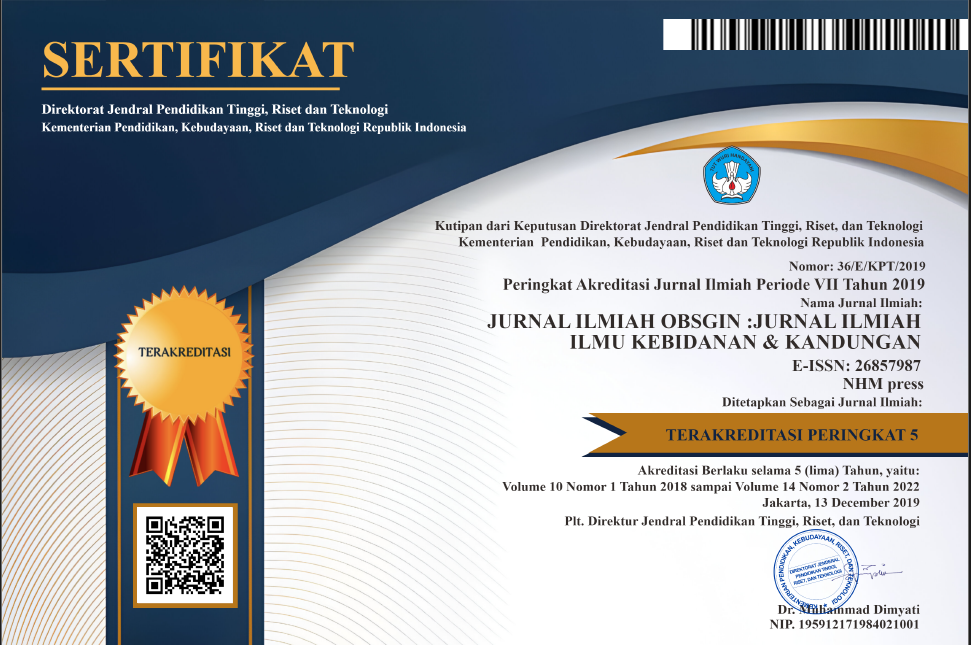PENGARUH PERMAINAN ULAR TANGGA TERHADAP PERKEMBANGAN ANAK USIA 48-59 BULAN
Abstract
The World Health Organization (WHO) reports that 5-25% of preschool-aged children suffer from minor brain dysfunctions, including impaired fine motor development. According to Kay-Lambkin, et al, globally, it is reported that children who experience disorders in the form of anxiety are around 9%, easily emotional 11-15%, behavioral disorders 9-15% (Wilar, 2015). The Ministry of Health of the Republic of Indonesia (2017) reports that 0.4 million (16%) Indonesian toddlers experience developmental disorders, both fine and gross motor development, hearing loss, low intelligence and speech delays. The purpose of this study was to determine the effect of snake and ladder game on the development of children aged 48-59 months in Sungai Tawar Village, East Tanjab Regency. This study used a quasi-experimental method with a one group pre test post test design. The population in this study were all toddlers aged 48-59 months in Sungai Tawar Village as many as 33 people. The number of samples as many as 33 people were taken by total sampling technique, statistical analysis test using the Wilcoxon test. Results of the Wilcoxon test, it was found that 33 respondents all experienced increased development after playing snake and ladder with a mean rank of 17 and a p-value of 0.000. Where the results of the study before playing snakes and ladders the average child development of 9.6. After playing snake and ladder the average development of children increased to 16. Statistically, it can be interpreted that the game of snakes and ladders affects the development of children aged 48-59 months in Sungai Tawar Village, East Tanjab Regency in. It is expected that health workers can apply the game of snakes and ladders in stimulating the development of children aged 48-59 months.
References
Depkes, R. I. (2006). Pedoman pelaksanaan stimulasi, deteksi dan intervensi dini tumbuh kembang anak di tingkat pelayanan kesehatan dasar. Jakarta: Depkes RI, 7–49.
Fitriani, R., & Adawiyah, R. (2021). Penerapan permainan tradisional Bakiak Ular Tangga untuk menstimulasi perkembangan sosial emosional anak. Jurnal Golden Age, 5(01), 1–13.
Fransisca, R., Wulan, S., & Supena, A. (2020). Meningkatkan percaya diri anak dengan permainan ular tangga edukasi. Jurnal Obsesi: Jurnal Pendidikan Anak Usia Dini, 4(2), 630–638.
Indriasih, A. (2015). Pemanfaatan alat permainan edukatif ular tangga dalam penerapan pembelajaran tematik di kelas III SD. Jurnal Pendidikan, 16(2), 127–137.
La Ode Alifariki, S. K. (2020). Gizi Anak dan Stunting. Penerbit LeutikaPrio.
Marâ, H., Priyanto, W., & Damayani, A. T. (2019). Pengembangan media pembelajaran tematik ular tangga berbagai pekerjaan. Mimbar PGSD Undiksha, 7(3).
Musfiroh, T. (2005). Bermain sambil belajar dan mengasah kecerdasan. Jakarta: Depdiknas.
Nawafilah, N. Q., & Masruroh, M. (2020). Pengembangan Alat Permainan Edukatif Ular Tangga Matematika untuk Meningkatkan Kemampuan Berhitung Anak Kelas III SDN Guminingrejo Tikung Lamongan. Jurnal Abdimas Berdaya: Jurnal Pembelajaran, Pemberdayaan Dan Pengabdian Masyarakat, 3(01), 37–46.
Rekysika, N. S., & Haryanto, H. (2019). Media pembelajaran ular tangga bilangan untuk meningkatkan kemampuan kognitif anak usia 5-6 tahun. Cakrawala Dini: Jurnal Pendidikan Anak Usia Dini, 10(1), 56–61.
Widi, S. C. P. (2015). Kemampuan Motorik Kasar dan Halus Anak Usia 4-6 Tahun. Jurnal Pendidikan Jasmani Indonesia, 11(2).












